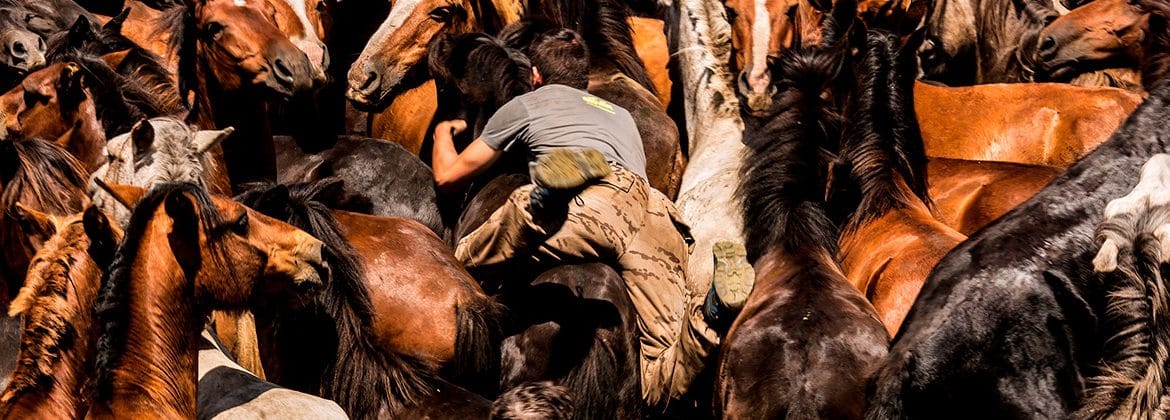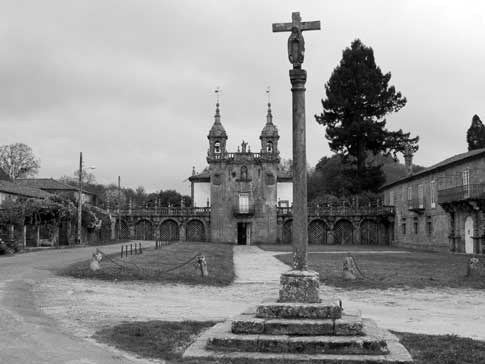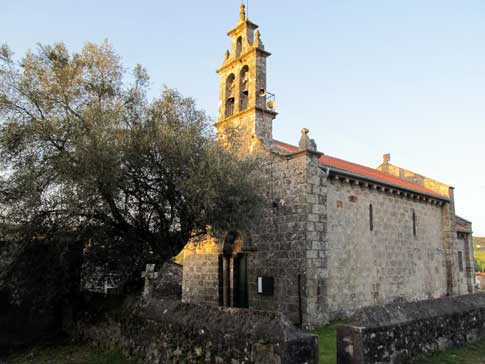Sabucedo consists of a very small city center. The main historic attraction is the Romanesque Iglesia de San Lorenzo de Sabucedo, built in the 12th century and rebuilt in the middle of the 19th. At its side, you’ll find the old curro for the shaving of the mares (whose story is told in the previous section). The city hall is also a cool place to see, with its eclectic style and tower topped by a cupola. The most exciting day to visit is Wednesday because of the market that is held. There are also big festivals held on the Tuesday before Easter and on November 13th.
Given its historical connection to the cathedral of Santiago de Compostela, many Romanesque churches are preserved throughout A Estrada. Based on all these churches, the Ruta del Románico is made up of 19 churches representing the style, although some have Baroque remodeling. Of all these churches, we will tell you about the most remarkable. The Iglesia de Santa María de Frades, built in the 12th century, is a true architectural gem, which exhibits a Romanesque spirit. This church consists of a rectangular apse and a barrel vault, with a large nave divided into three sections by pairs of adjoining columns. San Lorenzo de Ouzande has a semicircular apse with lots of half-point arches with beautiful capitals. The church of San Xurxo de Codeseda (San Jorge) shows all the richness of the Romanesque in its rectangular apse, buttresses, and modillions. The church of San Miguel de Moreira has the most characteristic collection of modillions with human figures, monsters, and human heads. The Iglesia de Santa María de Loimil boasts a nave and a rectangular apse with a beautiful cross made of links over the Testero del Agnus Dei, among other elements. Other interesting temples of various types are San Pedro de Ancorados, which has pentagonal apses; San Martiño de Riobó and San Estevo de Oca, which have semicircular apsees; and Santo Tomé de Ancorados, Santa Mariña da Barcala, and Santiago de Tabeiós, all of whom have rectangular apses.
The tradition of working with wood should also be included in this article, since A Estrada is the furniture capital of Galicia. There are artisanal networks on the outskirts of the village, and in order to promote the guild in addition to the annual fairs, the town recently opened the Museo del Mueble y de la Madera de Estrada (MOME). This museum is didactic and interactive, and you can learn all about using wood to make furniture. In the village of A Estrada, you’ll also find the Museo de Manuel Reimóndez Portela, which houses many bibliographic, documentary, photographic, and administrative accounts of A Estrada’s history.
On the outskirts of the town, you’ll find the Monasterio de Carboeiro, a church built by Gonzalo and Teresa, counts of Deza, in the year 936. It has a floorplan shaped like a Latin cross with three naves and another cross. In a vaulted arch over the door, you can see the representation of the Pórtico de la Gloria, with the Ancianos del Apocalipsis. It is considered a Galician, Romanesque gem, and it is said to be “unsurpassed by any monastery of its type and age.”
13 kilometers to the north of the town center, you’ll find the celebrated Pazo de Oca, owned by the Fundación Casa Ducal de Medinaceli, which is one of the most stately and well-preserved Galician palaces. It is even called the “Galician Versailles,” and it was declared a historical and artistic monument. Its construction was ordered by Álvaro de Oca on top of an ancient military building from the middle of the 15th century. The current structure is in the later Baroque style. It would be an injustice to leave out of this article the three most important parts of the ensemble. The first is the chapel, whose Baroque exterior boasts a tower in the corner. The second is the pazo itself, and the third is its gardens, which is the most popular part of the estate. It has a fountain and a granary in the foreground and a pond with a stone boat in the most luscious part.



